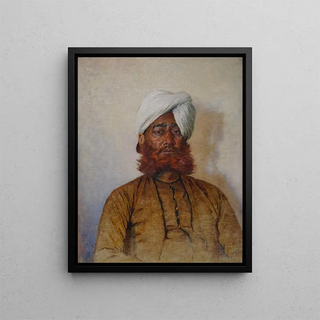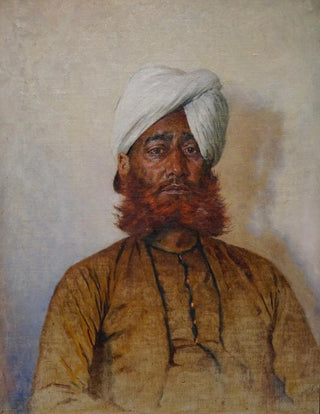Art print | Muslim official - Vasily Vereshchagin


View from behind

Frame (optional)
In the fascinating universe of art, some works transcend the simple frame of painting to become windows into bygone eras, distant cultures, and profound human emotions. "Muslim Official" by Vasily Vereshchagin is one of those creations that captivates the mind and sparks curiosity. This piece, painted in 1873, transports us to a world where the encounter between the East and West is palpable, where each brushstroke tells a story. Contemplating this art print, one immediately feels the importance of the representation, both faithful and artistic, of a Muslim official, an emblematic figure of a society in transition.
Style and uniqueness of the work
Vereshchagin's style is distinguished by its striking realism and its ability to capture the very essence of its subjects. In "Muslim Official," the artist deploys a rich and nuanced palette, playing with contrasts of light and shadow to bring his character to life. The composition is carefully orchestrated, with each element designed to enhance the visual impact of the piece. The official's gaze, both thoughtful and determined, invites us to reflect on the political and social issues of his time. Vereshchagin does not merely paint a man; he evokes an era, a culture, and a complex intercultural dialogue. His mastery of pictorial technique, combined with a deep understanding of human dynamics, gives this work a singularity that makes it timeless.
The artist and his influence
Vasily Vereshchagin, an emblematic figure of Russian art, is often regarded as one of the pioneers of military realism. His career, marked by travels across Central Asia and India, profoundly influenced his work. Through his artworks, he seeks not only to depict war but also to explore the cultures he encounters. His humanist approach, which favors empathy and understanding of others, is reflected in "Muslim Official." Vereshchagin does not hesitate to address delicate themes, such as colonization and its consequences, while celebrating the beauty and dignity of

Matte finish

View from behind

Frame (optional)
In the fascinating universe of art, some works transcend the simple frame of painting to become windows into bygone eras, distant cultures, and profound human emotions. "Muslim Official" by Vasily Vereshchagin is one of those creations that captivates the mind and sparks curiosity. This piece, painted in 1873, transports us to a world where the encounter between the East and West is palpable, where each brushstroke tells a story. Contemplating this art print, one immediately feels the importance of the representation, both faithful and artistic, of a Muslim official, an emblematic figure of a society in transition.
Style and uniqueness of the work
Vereshchagin's style is distinguished by its striking realism and its ability to capture the very essence of its subjects. In "Muslim Official," the artist deploys a rich and nuanced palette, playing with contrasts of light and shadow to bring his character to life. The composition is carefully orchestrated, with each element designed to enhance the visual impact of the piece. The official's gaze, both thoughtful and determined, invites us to reflect on the political and social issues of his time. Vereshchagin does not merely paint a man; he evokes an era, a culture, and a complex intercultural dialogue. His mastery of pictorial technique, combined with a deep understanding of human dynamics, gives this work a singularity that makes it timeless.
The artist and his influence
Vasily Vereshchagin, an emblematic figure of Russian art, is often regarded as one of the pioneers of military realism. His career, marked by travels across Central Asia and India, profoundly influenced his work. Through his artworks, he seeks not only to depict war but also to explore the cultures he encounters. His humanist approach, which favors empathy and understanding of others, is reflected in "Muslim Official." Vereshchagin does not hesitate to address delicate themes, such as colonization and its consequences, while celebrating the beauty and dignity of






